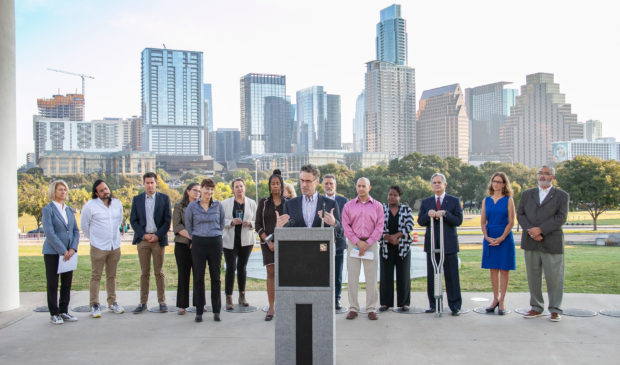City sees details of homelessness strategy, with push to raise $115M
Friday, October 22, 2021 by
Chad Swiatecki City Council learned in detail Thursday how its $210 million in federal aid, bond funds and other allocations will be used to address and possibly end homelessness over the next three years.
The presentation by Homeless Strategy Officer Dianna Grey focused largely on how the nearly $107 million the city received from the American Rescue Plan Act will be used to accomplish the goal of finding housing for 3,000 individuals and stabilizing another 2,300 households.
The plan details came on the same day a collective of local political leaders and representatives from social services groups and charitable foundations announced that $400 million has been raised toward the estimated $515 million cost of permanently ending homelessness in Austin. That figure was revealed at a spring summit of local leaders looking at how to use one-time federal aid on housing and social services for the homeless.
Since then the city has committed $210 million, with Travis County contributing $57 million and the state offering $92 million. Thursday’s announcement also marked the beginning of a push to raise the remaining $115 million from the private sector and philanthropic organizations.
Grey’s plan breaks the federal spending into five categories: crisis services ($10 million), core housing programs ($55 million), other services ($7 million), system capacity building ($9.2 million), and capital investment ($25.5 million).
Mayor Steve Adler said the plan will let the city take advantage of the “once in a generation” pool of funding to make significant improvements in housing and services for the homeless that for years have seemed out of reach.
“This is the work plans and operation plans that have been coming to us periodically, but we’ve never seen them in the context of actually being able to do it. When we were given initial numbers from one of the reports we adopted aspirationally and looking at what it would cost per year, I remember everyone’s eyes rolling back in their heads like, boy this would be great, but how do you ever actually do this?” he said.
Adler noted that, in recent years, the city has pursued scaled-down strategies to address specific homeless groups such as children and veterans.
“We truly are, I believe, on the cusp of being able to end homelessness in the city. If we are successful and can raise the last 25 percent – and I thoroughly expect us to be able to do that – we could be one of the first cities our size to be able to end homelessness.”
Council Member Kathie Tovo asked Grey to provide details on how the funding would be used for purposes such as improving outreach to the homeless, or what kind of targeted prevention programs would be used to keep people from losing their homes. Grey said there will likely be expanded capacity for the Homeless Outreach Street Team and coordinated work with groups such as ECHO, while increased rental assistance programs and outreach to landlords are two examples of preventative steps.
“We know we need to invest across the spectrum and your spending plan lays out clearly where those investments need to go related to housing an additional 3,000 people per year. Thank you for laying this out so clearly,” Tovo said, adding that donors will want to see a plan and accountability steps.
“This lays it out clearly that, if we want to see the true potential of our prevention services, for example, we’re going to need to see some additional funding coming forward from the private sector, as well as in every other category including mental health resources.”
Council Member Ann Kitchen pointed out the importance of funding to help organizations connected to homelessness services grow their capacity, in addition to adding more affordable units to the tight Austin housing market.
“This is exactly the kind of information I wanted to see coming back to us. It’s very succinct and understandable and it really shows us the path to truly addressing homelessness in our community,” Kitchen said.
“We talk a lot and perhaps think more about bricks-and-mortar housing, but it is important to note we need people, social workers and health clinicians to work with the folks living on the streets to help them get stability and into permanent housing.”
The Austin Monitor’s work is made possible by donations from the community. Though our reporting covers donors from time to time, we are careful to keep business and editorial efforts separate while maintaining transparency. A complete list of donors is available here, and our code of ethics is explained here.
You're a community leader
And we’re honored you look to us for serious, in-depth news. You know a strong community needs local and dedicated watchdog reporting. We’re here for you and that won’t change. Now will you take the powerful next step and support our nonprofit news organization?







